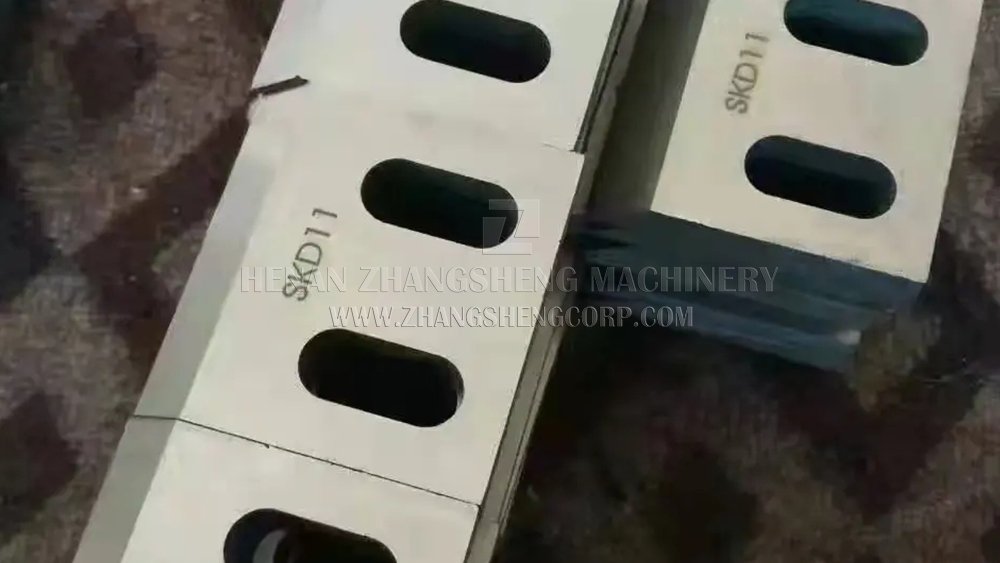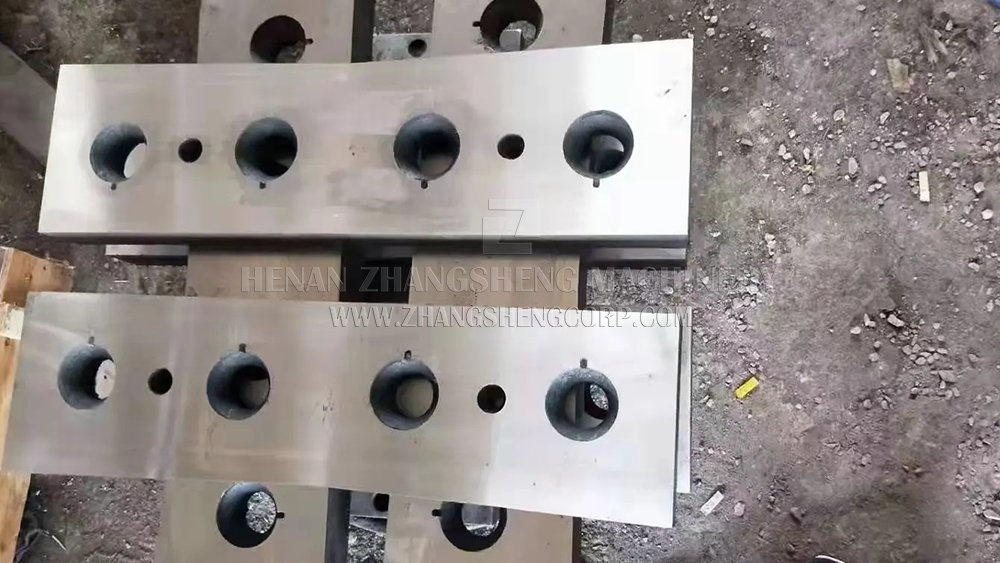Are your wood chipper blades feeling dull, making your machine work harder than it should? Many people wonder if they need a whole new set of blades or if there's a simpler solution to get back to efficient chipping.
Yes, wood chipper blades can be sharpened, and it is a routine maintenance task. Regularly sharpening your blades helps maintain optimal chipping performance, extends the blade's overall service life, and reduces strain on the machine.
From my 22 years in the business of manufacturing and exporting wood processing equipment, I've seen countless chippers. I know that keeping blades sharp is crucial. Our factory builds machines designed for durability, but even the best blades will dull over time. Think of it like a kitchen knife; a dull one does not cut well, and the same is true for a chipper. Maintaining sharp blades is part of ensuring your chipper runs efficiently and safely. It helps produce high-quality chips, reduces engine strain, and improves overall productivity.
How long do wood chipper blades last?
Are you wondering how often you'll need to deal with your chipper blades? The lifespan of a wood chipper blade is not fixed, and it depends a lot on how you use your machine.
The lifespan of wood chipper blades varies widely, influenced by factors such as the type and cleanliness of the wood being processed, the quality of the blade material, and proper machine operation. Blades can last anywhere from a few hours when processing hard, sandy wood to hundreds of hours with cleaner, softer wood and proper maintenance.

I always tell our customers that blade life is not just about the hours you run the machine. It is about what you put into it. For example, processing hardwoods like oak and maple will wear blades down faster than softer woods like pine. Any dirt, sand, or foreign objects mixed with the wood can drastically reduce blade life. It is like running sandpaper through your chipper. We design our machines with robust components, and our blades use high-quality, hardened tool steel to last longer and resist chipping. But even with the best materials, contaminants are the enemy of blades. Our smart feeding systems help optimize the feed rate, which also lessens stress on the blades.
What factors affect blade lifespan?
Are you curious about what makes some blades last longer than others? Many elements play a role in how long your wood chipper blades stay sharp and effective.
The lifespan of wood chipper blades is affected by the type and hardness of the wood, its cleanliness and the presence of contaminants, the quality of the blade material, the machine's operational methods like feed rate, and the correct adjustment of components like the anvil.
| Factor | Impact on Blade Life | Zhangsheng Consideration |
|---|---|---|
| Wood Type & Hardness | Hardwoods (oak, hickory) wear blades faster than softwoods (pine, fir). Processing palm or high-silica wood (like bamboo) can cause significant wear. | Our machines are designed for a variety of wood types, using blade materials like H12, 6652Si, or A8B with varying resistance to wear from different woods. A8B forged material, for example, is best for high-silica wood. |
| Wood Condition | Clean wood allows longer blade life. Dirt, sand, or debris drastically reduce blade life. | We advise customers to clean wood as much as possible before chipping to maximize blade longevity. Our feeding conveyors can help manage material, but pre-sorting is always best. |
| Presence of Contaminants | Metal, stones, or other foreign objects can chip or ruin blades instantly. Minor contaminants can break blades, which can cause dangerous projectiles. | Our feed systems are robust, but contaminants are the enemy of blades. Our smart feeding system can automatically adjust the feed speed or stop feeding to help prevent blockages and protect blades and the engine if something unexpected is detected. Our user-friendly controls also allow operators to stop or reverse the feed to protect blades. |
| Blade Material & Quality | High-quality, hardened steel blades hold an edge longer and resist damage. For example, H12 tool steel blades can last 8-12 hours between sharpenings, while A8B can last 15-25 hours. | Zhangsheng uses premium materials for our blades, a key aspect of our "International Quality" promise. We offer various blade materials like 6652Si, H12, and A8B, with A8B forged being the most comprehensive for high wear, impact, and high-silica wood. |
| Machine Operation | Overfeeding or forcing material can stress blades. Excessive rotor speed (over 600rpm) can increase wear by 30%. | Our smart feeding systems help optimize this by monitoring the load and automatically adjusting the feed, but operator awareness is also key. An intuitive control panel helps you monitor machine status and minimize maintenance. |
| Anvil Adjustment | The correct gap between the blade and anvil ensures clean cutting and prevents undue wear. | We provide clear guidance on anvil adjustment in our manuals and through our 24/7 after-sales support. An improperly set anvil can cause premature blade wear or damage. |
I recall a customer who was consistently dealing with very hard, fibrous wood. They struggled with blade life until they switched to our machines equipped with A8B forged blades. The difference in their operational efficiency and blade longevity was remarkable. It showed me once again that selecting the right blade material for your specific applications is vital to performance.

Can the blades on a wood chipper be sharpened?
You've heard that wood chipper blades can be sharpened, but how exactly is it done, and what signs should you look for to know it's time? Getting this right saves you money and keeps your machine working efficiently.
Yes, the blades on a wood chipper can be sharpened many times before they need to be replaced, extending their overall service life. This process involves grinding the cutting edges to restore their sharpness, and it's essential to follow specific guidelines for grinding amount and angle to ensure proper function.
When I talk about sharpening, I mean regular maintenance, not a one-time fix. Our high-quality blades are made to be sharpened multiple times, which helps you get better value from your investment. The blades need to be removed from the chipper to be professionally sharpened or precisely ground. It is not enough to just make them "sharp." You need to maintain the correct angle and ensure the blades in a set are balanced. This precision ensures effective cutting and reduces vibration that could damage the machine.
How do you know when to sharpen or replace blades?
Are you unsure when your chipper blades need attention? Recognizing the signs of dull or damaged blades is key to maintaining your machine and preventing bigger problems.
You should sharpen your wood chipper blades when you see visual signs like notches or reflection on the edge, or when the machine's performance declines with increased energy consumption, reduced output, or abnormal noise. Replacing them is necessary when they reach a certain cumulative grinding limit or are severely damaged.
| Indication Category | Specific Signs & How Often to Check | Action Required |
|---|---|---|
| Visual Inspection | Daily Check: Before each use, visually inspect for damage like chips, cracks, or uneven wear. Every 10 Hours: Check the tools (blades) for wear. Notches/Chips: If a blade edge has a notch of ≥0.5mm. Wear Mark: If the blade edge shows a noticeable reflective wear band (width >2mm). | Sharpen: If dull or showing minor wear. The grinding amount per sharpening should not exceed 0.1mm if there is no obvious chip, otherwise grind until the chip is gone. Maintain an angle tolerance of ±0.5°. It is recommended to sharpen blades from the same rotor in a set (e.g., 4 blades at once) for balance. |
| Performance Degradation | Increased Energy Consumption: Energy consumption rises by more than 15%. Reduced Output: Output significantly decreases by 30-50%. Poor Chip Quality: Finished chip size qualification rate drops below 90%. Abnormal Vibration/Noise: Machine produces unusual vibrations or noises. | Sharpen: These are strong indicators that the blades are dull and causing the machine to work harder. Sharpening will restore efficiency. Check Other Components: Also inspect other key components, such as bearings and belts, as they might be prone to wear and affect overall efficiency. |
| Replacement Thresholds | Chipped or Nicked Blades: If blades are chipped or severely nicked beyond repair by normal sharpening. Cumulative Grinding: When the cumulative grinding volume reaches 3-4 cm. | Replace: Blades that are too damaged or too worn out from repeated sharpening must be replaced. |
| Specific Materials | Hard Fibrous Materials: Immediately inspect the blade edge after processing hard fibrous materials like palm. New Blades: Inspect new blades after the first 4-8 hours of use. | Inspect/Sharpen/Replace: These materials can cause significant wear. New blades need an early check for any initial wear patterns. |
From my experience, catching dullness early saves a lot of trouble. I've heard stories from customers who delayed sharpening, only to find their chipper struggling, using more fuel, and making terrible noises. When they finally serviced the blades, they were amazed at the difference. Regular maintenance, including checking and sharpening blades, is really the secret to keeping your wood chipper in top shape.
Conclusion
Wood chipper blades can and should be sharpened regularly to maintain optimal performance and extend their lifespan. By monitoring factors like wood type, cleanliness, and the blade's condition, you can determine when sharpening is needed to ensure efficient operation and avoid costly replacements.
```


